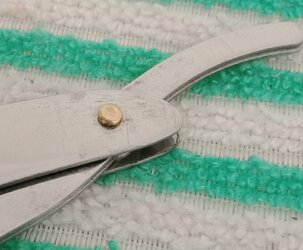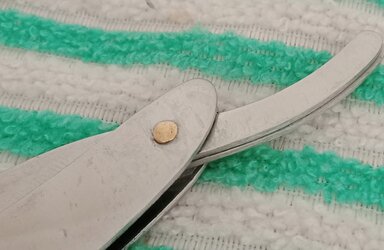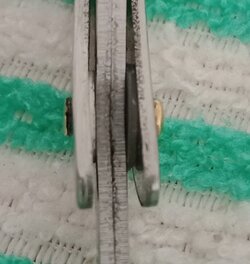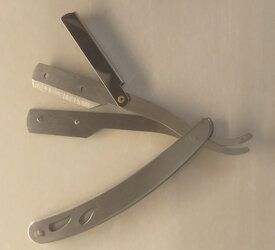rbscebu
Girls call me Makaluod
I had noticed that one of the plastic washers looked like it had broken at the pivot of my Oxor badged generic Chinese SS RBSR. I ordered a packet of 1.6mm x 5mm plastic washers and they arrive Friday. On Sunday I decided to replace the broken washer.
I held the razor in my small bench vice and proceeded to file the peined pin head using a flat jeweller's file. As I got closed to the scales, I applied some insulation tape to protect them. Once must of the peined head was gone, I used a small nail (filed flat at the point) and a 2oz jeweller's hammer to drive the brass pin through the top scale and disassemble the razor.
It was then that I found out that the pin diameter was not standard but rather about 2mm. My new plastic washers were not going to fit. I considered trying to drill out one of the new plastic washers but decided that would be too finicky for me.
I hunted around the house and found some firm plastic that I thought I could work with. I drilled a suitable hole in this plastic and cut it into the shape of a washer that I could use.
I was also worried that I now did not have suitable material with which to use as a new pivot pin. My stock was only 1.6mm diameter. Upon reassembling the razor, it looked like there was still enough meat in the old pin to pein. It was then (luckily) that I noticed I had assembled the razor upside down. Lesson learnt.
Once all was corrected, I commenced re-peining the old pin used a a jeweller's ball-pein hammer. All worked well. My first re-pinning was a success!
Here is the finished result.

What I learnt was that I can do it. I also need to take a bit more care not to scratch/mark the scales when filing and peining.
Next I might try it on an old Puma SR that needs a cleanup around the pivot pin area.
I held the razor in my small bench vice and proceeded to file the peined pin head using a flat jeweller's file. As I got closed to the scales, I applied some insulation tape to protect them. Once must of the peined head was gone, I used a small nail (filed flat at the point) and a 2oz jeweller's hammer to drive the brass pin through the top scale and disassemble the razor.
It was then that I found out that the pin diameter was not standard but rather about 2mm. My new plastic washers were not going to fit. I considered trying to drill out one of the new plastic washers but decided that would be too finicky for me.
I hunted around the house and found some firm plastic that I thought I could work with. I drilled a suitable hole in this plastic and cut it into the shape of a washer that I could use.
I was also worried that I now did not have suitable material with which to use as a new pivot pin. My stock was only 1.6mm diameter. Upon reassembling the razor, it looked like there was still enough meat in the old pin to pein. It was then (luckily) that I noticed I had assembled the razor upside down. Lesson learnt.
Once all was corrected, I commenced re-peining the old pin used a a jeweller's ball-pein hammer. All worked well. My first re-pinning was a success!
Here is the finished result.

What I learnt was that I can do it. I also need to take a bit more care not to scratch/mark the scales when filing and peining.
Next I might try it on an old Puma SR that needs a cleanup around the pivot pin area.




